Related Research Articles

Herne Bay is a seaside town in Kent, South East England, with a population of 38,563. On the south coast of the Thames Estuary, it is 6 miles (10 km) north of Canterbury and 4 miles (6 km) east of Whitstable. It neighbours the ancient villages of Herne and Reculver and is part of the City of Canterbury local government district, although it remains a separate town, with countryside between it and Canterbury. Herne Bay's seafront is home to the world's first freestanding purpose-built Clock Tower, built in 1837; from the late Victorian period until 1978, the town had the second-longest pier in the United Kingdom.

The City of Canterbury is a local government district with city status in Kent, England. As well as Canterbury itself, the district extends north to the coastal towns of Whistable and Herne Bay.

Reculver is a village and coastal resort about 3 miles (5 km) east of Herne Bay in south-east England, in a ward of the same name, in the City of Canterbury district of Kent. It once occupied a strategic location at the north-western end of the Wantsum Channel, a sea lane that separated the Isle of Thanet and the Kent mainland until the late Middle Ages. This led the Romans to build a small fort there at the time of their conquest of Britain in 43 AD, and, starting late in the 2nd century, they built a larger fort, or castrum, called Regulbium, which later became one of the chain of Saxon Shore forts. Following the withdrawal of the Western Roman Empire in ca. early C4th, the Brythons again took control of the lands until Anglo-Saxon invasions shortly afterward.
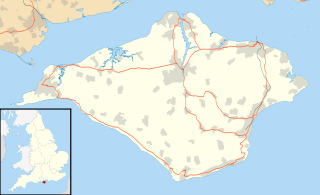
Fort Victoria is a former military fort on the Isle of Wight, England, built to guard the Solent. The earliest fort on the site was a coastal fort known as Sharpenode Bulwark built in 1545–1547 by Henry VIII, but these defences had fallen into disrepair by the 17th century. Fort Victoria was built in the 1850s. It was a brick-built triangular fort with two seaward batteries meeting at a right angle. It remained in use until 1962. Parts of the fort were subsequently demolished, and what remains has become part of Fort Victoria Country Park.

Herne Bay railway station is on the Chatham Main Line in England, serving the town of Herne Bay, Kent. It is 62 miles 58 chains (100.9 km) down the line from London Victoria and is situated between Chestfield & Swalecliffe and Birchington-on-Sea.
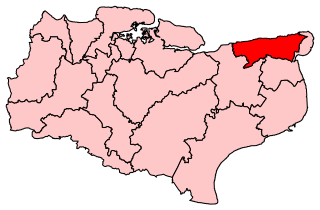
North Thanet is a constituency represented in the House of Commons of the UK Parliament since its 1983 creation by Sir Roger Gale, a Conservative.

Southport Pier is a pleasure pier in Southport, Merseyside, England. Opened in August 1860, it is the oldest iron pier in the country. Its length of 1,108 m (3,635 ft) makes it the second-longest in Great Britain, after Southend Pier. Although at one time spanning 1,340 m (4,380 ft), a succession of storms and fires during the late 19th and early 20th centuries reduced its length to that of the present day.
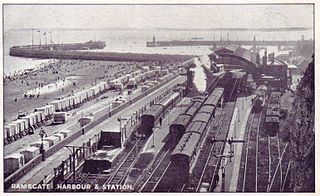
Ramsgate Harbour railway station is a former railway station in Ramsgate, in the Thanet district of Kent, England. Opened in 1863 as part of the Kent Coast Railway company's extension of its line from Herne Bay, it was conveniently situated for the seaside resort's beach, but it closed in 1926 after a reorganisation of railway lines in the Thanet area.
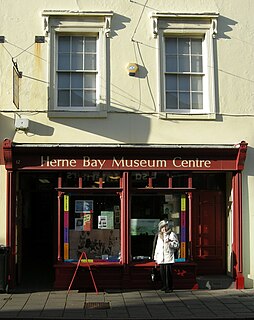
The Seaside Museum Herne Bay is a local museum in Herne Bay, Kent, England. It was established in 1932 and is notable for being a seaside tourist attraction featuring local archaeological and social history, for featuring the history of the town as a tourist resort, for its local art exhibitions, and for its World War II bouncing bomb. The management of the Museum was awarded by Canterbury City Council to the Herne Bay Museum Trust, who reopened it in July 2015 as The Seaside Museum Herne Bay.

Herne Bay Pier was the third pier to be built at Herne Bay, Kent for passenger steamers. It was notable for its length of 3,787 feet (1,154 m) and for appearing in the opening sequence of Ken Russell's first feature film French Dressing. It was destroyed in a storm in 1978 and dismantled in 1980, leaving a stub with sports centre at the landward end, and part of the landing stage isolated at sea. It was preceded by two piers: a wooden deep-sea pier designed by Thomas Rhodes, assistant of Thomas Telford, and a second shorter iron version by Wilkinson & Smith.

Hampton-on-Sea was a drowned and abandoned village in what is now the Hampton area of Herne Bay, Kent. It grew from a tiny fishing hamlet in 1864 at the hands of an oyster fishery company, was developed from 1879 by land agents, abandoned in 1916 and finally drowned due to coastal erosion by 1921. All that now remains is the stub of the original pier, the Hampton Inn, and the rocky arc of Hampton-on-Sea's ruined coastal defence visible at low tide. The site is notable for sharing its history with the eccentric Edmund Reid. Reid was previously the Metropolitan Police head of CID who handled the Jack the Ripper case. In retirement he chose to champion the plight of the beleaguered residents of the settlement.

Frederick Christian Palmer, known professionally as Fred C. Palmer, was the main public photographer of Herne Bay, Kent in the early years of the 20th century, working from Tower Studio. He photographed all the civic events in Herne Bay before 1914, and made portraits of the eccentric Edmund Reid, the erstwhile head of Metropolitan Police Service CID who had investigated the Whitechapel murders and then retired to Hampton-on-Sea, Herne Bay. In 1913 Marcel Duchamp used Palmer's 1910 photograph of the illuminated Grand Pier Pavilion as found object art in his Note 78, part of his Green Box artwork. In the 1920s and early 30s, Palmer took over William Hooper's Cromwell Street studio in Swindon, again producing local postcards, photographing prominent people and doing freelance work for local newspapers and the Council.
Southend-on-Sea Corporation Tramways served the town of Southend-on-Sea in Essex from 19 July 1901 until 8 April 1942.

St Anne's Pier is a Victorian era pleasure pier in the English seaside resort of St Anne's-on-the-Sea, Lancashire. It lies on the estuary of the River Ribble. The pier, designed by A. Dowson, was completed in 1885 and was one of the earliest public buildings in St Anne's, a 19th-century planned town. The pier was originally intended to be a sedate promenading venue for the resort's visitors, but attractions were later added. Changes made to the estuary channels to improve access to Preston Dock left the pier on dry land and ended its steamer services to Blackpool and Liverpool.
![1978 North Sea storm surge A storm surge which occurred over 11–12 January causing extensive [[coastal flooding]] and considerable damage on the east coast of England between the Humber and Kent](https://upload.wikimedia.org/wikipedia/commons/thumb/2/29/Burning_debris_from_destroyed_pier_on_Margate_beach.jpg/320px-Burning_debris_from_destroyed_pier_on_Margate_beach.jpg)
1978 North Sea storm surge was a storm surge which occurred over 11–12 January causing extensive coastal flooding and considerable damage on the east coast of England between the Humber and Kent. Higher water levels were reached than during the devastating North Sea flood of 1953 from North Shields to King's Lynn, but values were lower towards the Thames. Locally severe flooding occurred in Lincolnshire, The Wash, north Norfolk and Kent. Improvements in flood protection following the devastating flood of 1953 meant that the catastrophic losses seen during that storm were not repeated. The storm caused severe damage to many piers along the east coast of England.
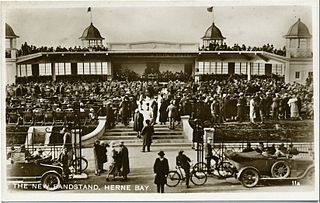
The Central Bandstand, known as the Bandstand, in Herne Bay, Kent, England, was designed by H. Kempton Dyson in 1924, extended with an art deco frontage in 1932, and refurbished between 1998 and 1999. It is one of the coastal landmarks of the town. When first built, it was a popular venue for visiting military band concerts and for tea dances. Edwina Mountbatten spoke there on behalf of the Red Cross in 1939. In the 1920s and 1930s a red carpet would be laid across the road and up to the stage for the conductor of the brass band to walk from the Connaught Hotel which was directly opposite the Bandstand.

The King's Hall is a theatre, concert hall and dance hall at Herne Bay, Kent, England. It was built as The Pavilion in 1903–1904, developed as the King Edward VII Memorial Hall in 1913 in memory of the late king, and was being called The King's Hall by 1912 while still at planning stage. Both building phases were designed by the local Council surveyor F.W.J. Palmer, CE. The year 2013 was the centenary of the completion of the second and final phase of this building and its grand opening by Princess Beatrice on 10 July 1913.

Frederick William J. Palmer, CE, (1864–1947), known professionally as F. W. J. Palmer, was an English civil engineer, structural engineer and surveyor. From 1891 he was Surveyor to Herne Bay Urban District Council. As Town Surveyor between at least 1891 and 1915 he was responsible for digging up a great deal of Herne Bay. He reconstructed all the main roads, rebuilt the council offices and Hampton Pier and constructed a new sea wall. He sewered the East Cliff and nine miles of private roads at the east end of Herne Bay. His crowning achievement was his design of both phases of the King's Hall, Herne Bay. His extensive works helped to provide employment and to make the town what it is today. Archaeological artefacts turned up by his constant digging contributed to the collection now in Herne Bay Museum.
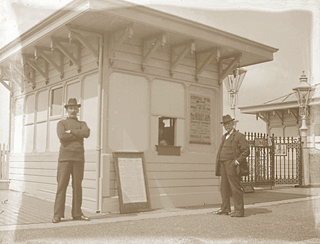
Central Pier was one of two piers in Morecambe, Lancashire, England, built during the late 1860s at a length of 912 feet (278 m) long and featured a large pier head served by steamboats. Two significant fires occurred during its lifetime, one in 1933 destroying the pavilion then dubbed the "Taj Mahal of the North", and another in 1991, the latter which condemned the pier as unsafe and demolition took place the following year in 1992.
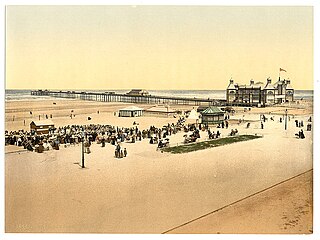
Rhyl Pier, officially known as the Victoria Pier, was a pleasure pier in the seaside town of Rhyl, Wales and the first to be built in North Wales. Opened in August 1867 at a length of over half a mile, it was the town's central attraction for the years that followed. Following dispute and public consultation regarding the location it would be built, the pier was constructed near the centre of the esplanade.
References
Coordinates: 51°22′14″N1°05′53″E / 51.370535°N 1.098064°E
| | This Kent location article is a stub. You can help Wikipedia by expanding it. |